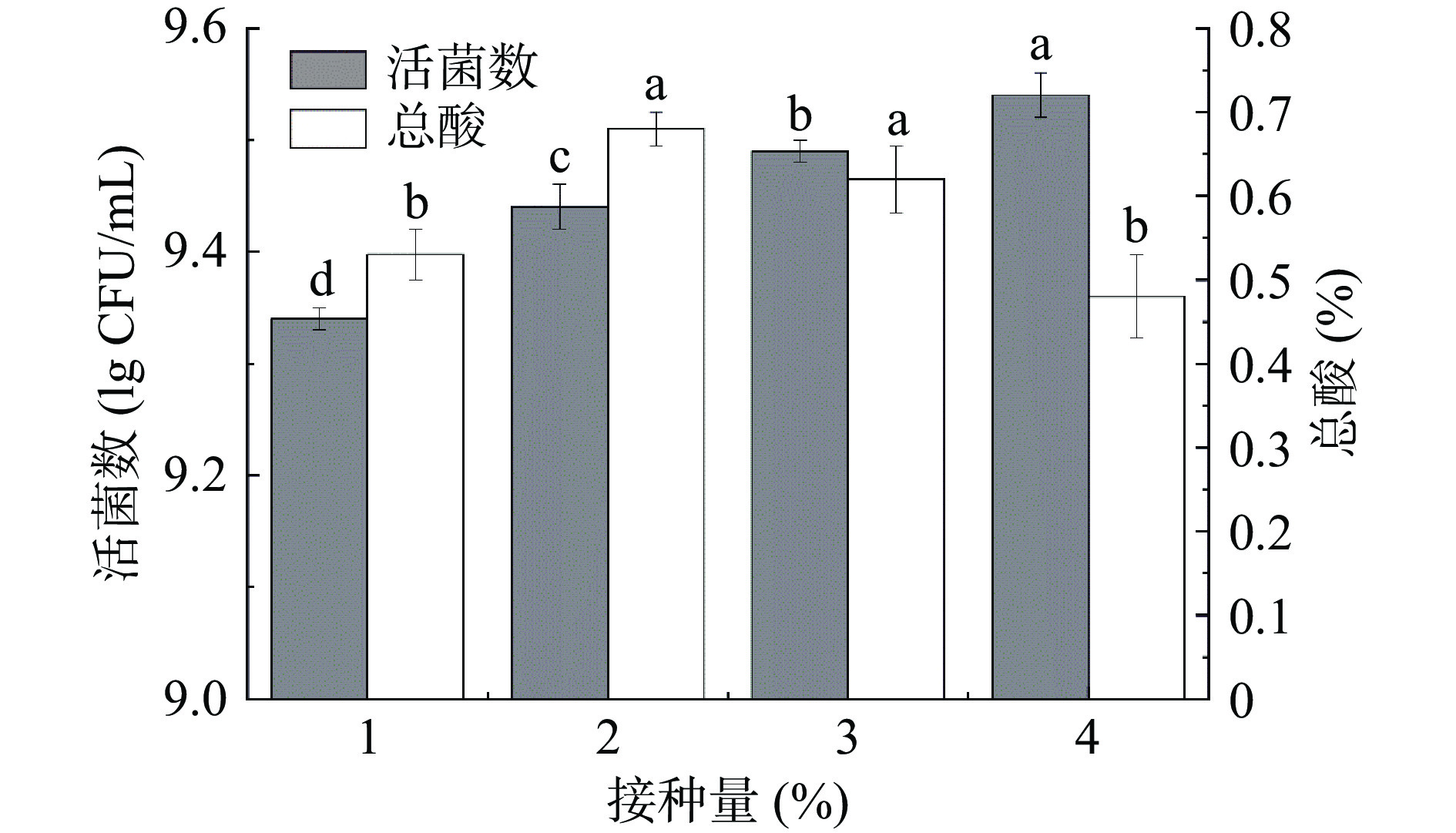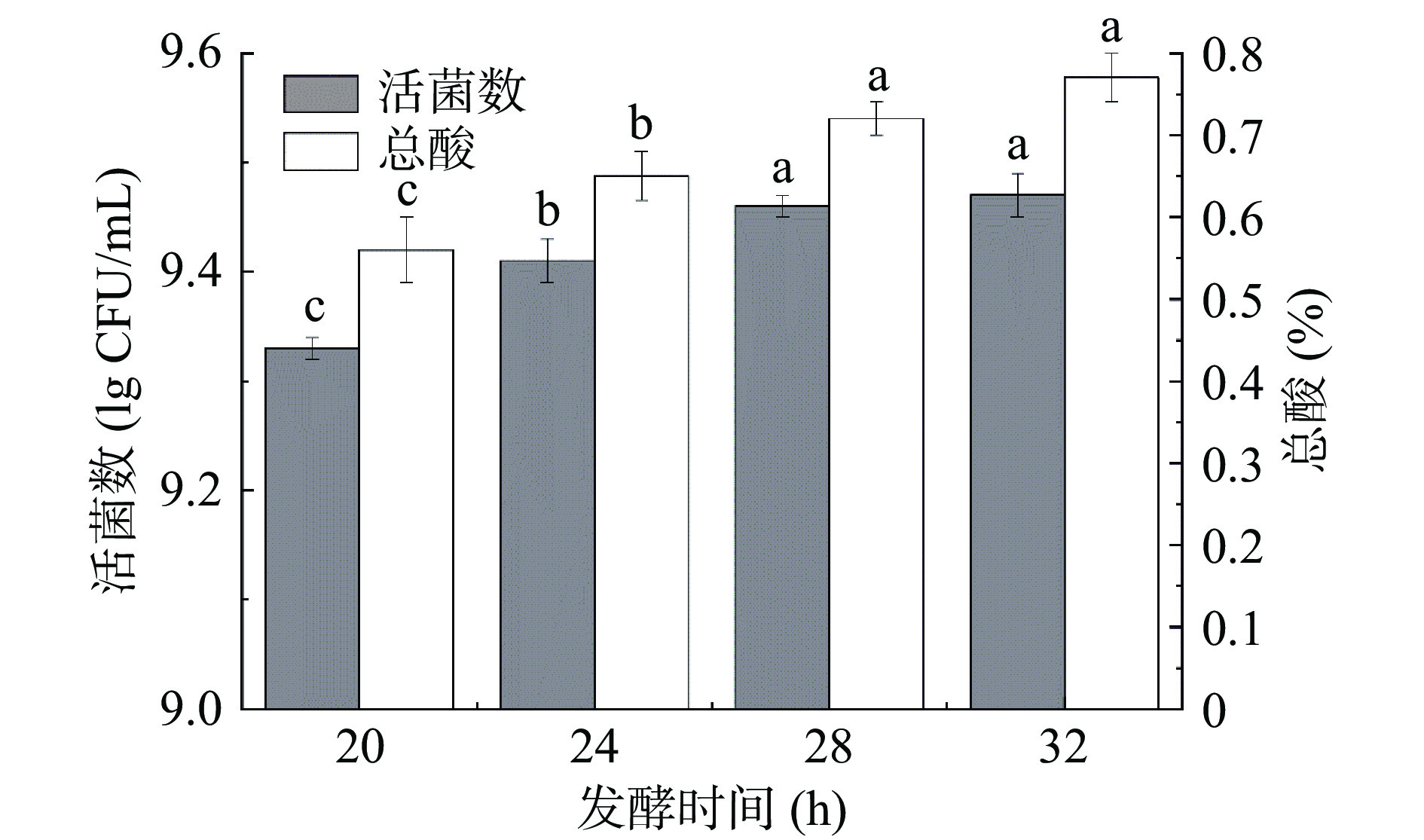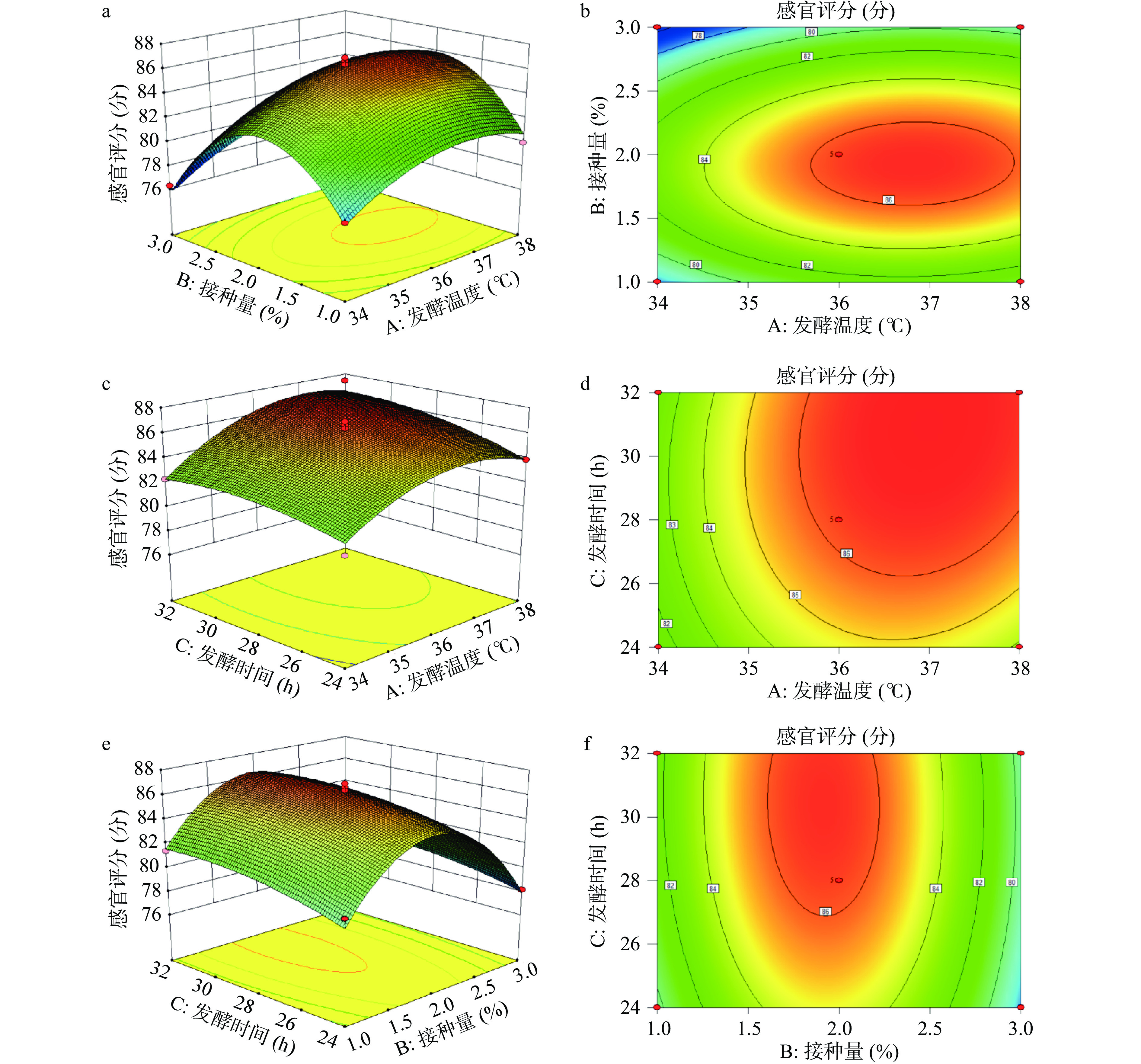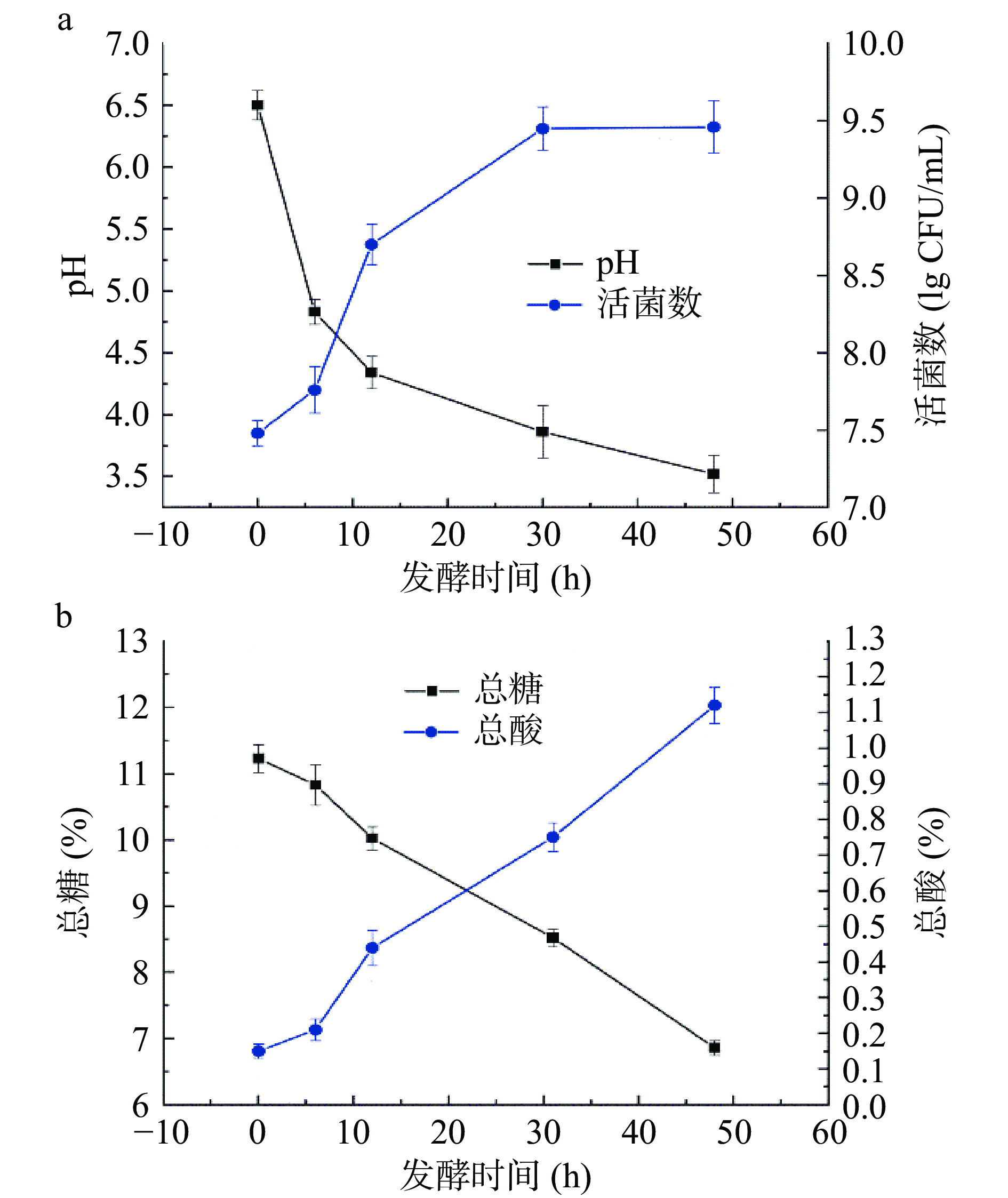Response Surface Optimization of the Fermentation Process of Tomato Juice by Lactobacillus plantarum and Its Quality Evaluation
-
摘要: 本文以番茄为原料,研发了一款植物乳杆菌发酵饮料。通过单因素及响应面试验确定了番茄汁最佳发酵工艺为发酵温度37 ℃、菌种接种量2%、发酵时间30 h。结果表明,在发酵过程中番茄汁的pH和总糖含量下降,总酸含量上升,活菌数持续上升后趋于稳定。番茄汁经最佳工艺发酵后,其总酚和总黄酮含量显著上升(P<0.05),ABTS+自由基清除率和DPPH自由基清除率显著提高,表明植物乳杆菌发酵提高了番茄汁的抗氧化能力;而番茄红素和β-胡萝卜素含量受加工和发酵的影响有所下降。对4 ℃贮藏21 d后的发酵终产品品质评估结果表明其感官、卫生和微生物指数均达标,符合发酵果蔬汁食用安全性要求。Abstract: A fermented beverage by Lactobacillus plantarum was developed using tomatoes as raw materials. Through single factor and response surface tests, the optimal fermentation process for tomato juice was determined as follows: Fermentation temperature of 37 ℃, bacterial inoculation of 2%, and fermentation time of 30 h. The results showed that during the fermentation process, the pH and the total sugar content of tomato juice decreased while the total acid content increased, and the number of viable bacteria initially increased (P<0.05) and then stabilized. After fermentation, the content of total phenols and total flavonoids in tomato juice significantly increased, and the scavenging rate of ABTS+ and DPPH free radicals also increased significantly, indicating that fermentation of tomato juice by Lactobacillus plantarum increased its antioxidant capacity. However, the lycopene and β-carotene content decreased as affected by processing and fermentation. The quality evaluation results of the final fermented tomato products after storage at 4 ℃ for 21 d showed that its sensory, hygienic and microbiological indicators were all up to the standards, and met the edible safety requirements of fermented fruit and vegetable juice.
-
番茄(Solanum lycopersicum),即西红柿,原产于南美洲,目前在中国大部分区域均有种植。番茄营养丰富,风味独特,口感酸甜[1]。此外,番茄含有丰富的果胶、苹果酸、柠檬酸、番茄红素、β-胡萝卜素、多酚及黄酮等活性物质[2],具有降血脂[3]、助消化[4]、提高人体免疫力[5]、抗衰老和抗癌等功能[6],因此深受消费者喜爱。然而,新鲜番茄含水量高、采后呼吸作用强烈,极易发生腐烂,导致其货架期较短,造成了很大的经济损失[7]。近年来,随着我国果蔬深加工技术的发展,番茄制品种类日益繁多,有效推动了番茄产业的发展,实现了采后减损增值。
目前,市场上常见的番茄制品主要包括番茄原汁和番茄调味料等。近年来,发酵型乳酸饮品由于其独特的风味,丰富的营养价值,深受消费者喜爱。因此,新型发酵番茄果汁品种日益增多。例如,杜冰等利用嗜酸乳杆菌发酵番茄汁,生产了一种新型功能饮料[8]。李鹏程等利用植物乳杆菌和干酪乳杆菌,发明了一种西瓜-番茄复合果蔬汁[9]。这些番茄发酵饮品在保留番茄原汁营养成分的同时,还增加了对人体有益的多种氨基酸成分,提高了番茄饮料的营养价值。
植物乳杆菌因其对植物性发酵基质的显著适应性和转化酚类物质的优势被广泛应用于果蔬的发酵过程,如蔬菜汁的发酵[10]、泡菜的制备[11]和葡萄酒的苹果酸-乳酸发酵[12]等。在发酵过程中,植物乳杆菌能够通过其增殖代谢过程,改善果蔬汁的成分组成,从而起到改善果蔬汁风味[13]、延缓果蔬汁品质败坏[14]及增加果蔬汁的保健功能[15]等作用。目前,多项研究证明植物乳杆菌(BNCC337796)具有较好的发酵功能。在银杏果发酵果汁的研究中发现,该菌具有良好的生长和产酸性能,有效改变了果汁中游离氨基酸的含量,丰富了银杏果果汁的风味;同时,它能降低果汁中银杏酸的含量,丰富萜烯内酯,代谢果汁中的酚类物质[16]。植物乳杆菌在发酵甘蓝汁液的过程中降解硫代葡萄糖苷,从而增强其活性[17]。然而,植物乳杆菌对于番茄汁的发酵作用尚不明确。
因此,本文拟通过单因素及响应面试验确定植物乳杆菌发酵番茄汁的最佳工艺条件,探究发酵对番茄汁中微生物代谢主要指标(pH、活菌数、总酸及总糖含量)、主要活性成分(番茄红素、β-胡萝卜素、总酚、总黄酮)以及抗氧化活性的影响,在此基础上评估发酵番茄汁经低温贮藏后的品质,以期为植物乳杆菌发酵番茄汁的工业化生产提供理论依据。
1. 材料与方法
1.1 材料与仪器
番茄(普罗旺斯) 购买自山东潍坊,新鲜采摘后,在低温条件下,迅速运至实验室;植物乳杆菌(BNCC337796)冻干粉 北京北纳生物保藏中心;MRS肉汤、MRS琼脂 上海盛思生化科技有限公司;氯化钠(分析纯) 国药集团化学试剂有限公司;抗坏血酸(分析纯) 上海源叶生物科技有限公司;羧甲基纤维素钠(食品级)、海藻酸丙二醇酯(食品级) 泰昌技术有限公司;黄原胶、琼脂、果胶及卡拉胶(均为食品级) 泰昌技术有限公司;蔗糖(食品级)、碳酸钠(分析纯) 南京寿德生物科技有限公司。
WYT-J糖度计 成都豪创光电仪器有限公司;MJ-BL25B2搅拌机 广东美的生活电器制造有限公司;LDZF-50KB型立式压力蒸汽灭菌锅 上海申安医疗器械厂;SW-CJ-1FD型单人单面净化工作台 苏州净化设备有限公司;PYX-DHS.500BS型隔水式电热恒温培养箱 上海跃进医疗器械有限公司;KQ-300DE型数控超声波清洗器 昆山市超声仪器有限公司;榨汁机 九阳股份有限公司;UV-1800型紫外分光光度计 日本岛津公司;3K15型冷冻离心机 德国Sigma公司;JA2003型电子天平 上海精密科学仪器有限公司;HH-4型数显恒温水浴锅 国华电器有限公司;CTHI-250B型恒温恒湿箱 美国施都凯设备公司;CR-13型便携式色差计 日本柯尼卡美能达公司。
1.2 实验方法
1.2.1 菌种制备
植物乳杆菌(BNCC337796)冻干粉混匀在MRS肉汤中经37 ℃活化24 h后,与50%的甘油按照1:1混合,于−20 ℃下长期保存。另取培养液转接到斜面培养基上,37 ℃下培养24 h后放置于4 ℃下短期保存,作为整个研究中的种子液制备菌种。挑取斜面菌落接种于50 mL无菌MRS肉汤中,37 ℃培养24 h后作为活化的种子液使用。通过稀释平板计数法,计算得到活菌数浓度约为1.5×109 CFU/mL。
1.2.2 番茄汁制备
选取无病虫害、颜色鲜红均匀、大小适中的番茄,用清水冲洗去表面污垢,去果蒂,在90 ℃清水中烫漂3 min并去皮。四分法切开番茄,经榨汁机榨汁后用四层纱布过滤。用饱和Na2CO3溶液调节番茄汁的pH至6.5(生番茄汁pH在4.3~4.4之间,植物乳杆菌的适宜生长pH为6.5左右),调节可溶性固形物含量到12°Brix。用恒温水浴锅将番茄汁中心温度加热到80 ℃并保持15 s杀菌,冷却待用。
1.2.3 番茄汁发酵工艺
1.2.3.1 单因素实验设计
分别以接种量、发酵时间和发酵温度作为发酵工艺过程中的单因素,以活菌数及总酸含量为指标进行单因素实验。其中,固定接种量2%、发酵时间24 h,考察发酵温度(32、36、40和44 ℃)对活菌数和总酸的影响;固定发酵时间24 h、发酵温度36 ℃,考察接种量(1%、2%、3%和4%)对活菌数和总酸的影响;固定接种量2%、发酵温度36 ℃,考察发酵时间(20、24、28和32 h)对活菌数和总酸的影响。
1.2.3.2 响应面试验设计
在单因素实验的基础上,以感官整体喜好度为响应值,对植物乳杆菌发酵番茄汁影响显著的3个因素,发酵温度(34、36和38 ℃)、植物乳杆菌接种量(1%、2%和3%)和发酵时间(24、28和32 h)为试验因素,利用Design-expert 8.0.5分析软件Box-Behnken进行试验设计(表1)。
表 1 番茄汁发酵工艺优化Box-Behnken试验因素与水平Table 1. Factors and levels of Box-Behnken test for the optimization of tomato juice fermentation process因素 水平 −1 0 1 A发酵温度(℃) 34 36 38 B接种量(%) 1 2 3 C发酵时间(h) 24 28 32 1.2.4 感官评价
感官评价参考卢嘉懿等[18]采用“双盲法”:由10个食品专业学生(男女各5人)组成感官评价小组,对发酵番茄汁饮料的“色、香、味、形”四个方面进行打分,除去最高和最低评分,其余结果取平均值,得到感官评分。感官评定标准见表2。
表 2 感官评定标准Table 2. Sensory evaluation standards评分项目 评分标准 得分(分) 色泽(20 分) 色泽自然透亮
色泽较鲜艳,有轻微褐变
色泽暗淡,褐变严重15~20
10~14
0~9香气(20 分) 有浓郁纯正的番茄香味
较浓郁,有一定番茄香味
番茄香味较淡,不明显15~20
10~14
0~9口感(40 分) 酸甜适口,味道清爽纯正
偏酸或偏甜,口味较纯正
酸甜比例不协调,过酸或过甜25~40
10~24
0~9组织形态(20 分) 组织形态均匀,无分层现象
组织形态较均匀,有轻微分层现象
组织形态不均匀,有明显分层现象15~20
10~14
0~91.2.5 发酵过程中番茄汁指标变化
接种量为2%的番茄汁在37 ℃下发酵,每隔6、12、30和48 h 取样测定发酵过程中活菌数、pH、总酸及总糖含量的变化。其中,活菌数的测定参照GB 4789.35-2010;总酸的测定参考GB/T 12456-2008;可溶性固形物采用手持糖度仪进行测定;pH采用pH计进行测定;总糖含量采用蒽酮比色法测定[19]。
1.2.6 发酵番茄汁活性分析及品质评估
经步骤1.2.3获得番茄汁的最佳发酵条件后,测量经最佳工艺条件发酵前后番茄汁中番茄红素、β-胡萝卜素及抗氧化活性的变化。番茄红素的测定参照NYT1651-2008;β-胡萝卜素的测定参照GB 5009.83-2016采用高效液相色谱法;VC含量测定采用钼蓝比色法[20];多酚含量的测定采用福林酚比色法[21];黄酮的测量方法采用氯化铝比色法[22];DPPH自由基清除能力和ABTS+自由基清除能力测定参照郝玉洁[23]的方法;羟自由基清除率和超氧自由基清除能力测定参照Li等[24]的方法。
经最佳工艺发酵后的番茄汁灌装于250 mL玻璃瓶中(每瓶200 mL),置于4 ℃下贮藏21 d。根据轻工业行业标准QBT 5356-2018对最终产品进行感官指标、理化指标和微生物指标的检测。
1.3 数据处理
采用Design-Expert.8.05 软件进行试验设计和方差分析,Origin 2018软件进行绘图,SPSS 20.0进行方差分析,差异显著性水平为0.05。每组实验均重复3次,结果以平均值±标准差表示。
2. 结果与分析
2.1 发酵工艺优化
2.1.1 发酵温度单因素实验结果
温度对番茄汁发酵的影响如图1所示。在32 ℃时,活菌数为9.36 log(CFU/mL),总酸含量为0.58%;在36 ℃时,活菌数增长到9.43 log(CFU/mL),总酸增长到0.66%。可以发现,随着温度的升高,番茄汁的活菌数和总酸量显著上升(P<0.05)。这可能是由于温度的上升导致了植物乳杆菌的活力升高,繁殖和产酸速率增快[25]。然而,在温度40 ℃时,发酵番茄汁的活菌数和总酸分别为9.38 log(CFU/mL)和0.6%,与32和36 ℃时相比稍有下降;发酵温度为44 ℃时,发酵番茄汁的活菌数为9.25 log(CFU/mL),总酸含量为0.47%,相比于40 ℃时,活菌数和总酸量显著下降(P<0.05),原因是发酵温度会对菌体内的蛋白质、酶活性产生直接影响。发酵温度过高会使菌体细胞内的蛋白质发生变性,影响菌体核糖体、RNA等大分子的稳定性,抑制菌体生长,从而导致活菌数和产酸量下降;而温度低时活菌数和总酸含量少,是由于发酵温度过低会降低酶的活力,引起细胞膜流动性变化,进而影响菌体的正常生长[26]。根据单因素实验结果,可以看出植物乳杆菌在32~40 ℃范围内在番茄汁中生长和产酸比较适宜,故选择34、36和38 ℃进行下一步的响应面试验。
2.1.2 接种量单因素实验结果
接种量对番茄汁发酵的影响如图2所示。当接种量为1%时,发酵后番茄汁中的活菌数为9.34 log(CFU/mL),总酸含量为0.53%;当接种量为2%时,发酵后番茄汁中的活菌数为9.44 log(CFU/mL),总酸含量为0.68%。随着初始接种量从1%升到2%,番茄汁发酵后的活菌数和总酸均显著提高(P<0.05)。当接种量升到3%时,发酵后番茄汁中的活菌数分别为9.49 log(CFU/mL),总酸为0.62%,活菌数提高,产酸量变化不显著。当接种量为4%时,发酵后番茄汁中的活菌数为9.54 log(CFU/mL),总酸量为0.48%,活菌数显著增加(P<0.05),总酸却显著减小(P<0.05)。推测是由于接种量过大时,植物乳杆菌在营养充足的情况下大量生长繁殖,发酵产酸速率快,发酵时间缩短,但由于有一部分营养物质会被用于菌种生长繁殖,在等量营养成分情况下,用于发酵产生营养成分的量就会相应减少,进而导致产酸量会下降。同理,接种量小,菌种初始基数小,产酸速率较慢,此时用于菌种生长繁殖的营养成分会变少,用于发酵产酸的成分量就会相应增加。但初始接种量过少导致的速率过慢也会导致在相同时间内产酸量过少,营养物质未被充分利用,导致发酵不充分[27]。综合结果来看,接种量为1%和4%时相应的总酸无显著变化(P>0.05),考虑成本问题,选择1%的接种量。最后选择1%、2%、3%接种量进行下一步的响应面优化试验。
2.1.3 发酵时间对番茄汁发酵的影响
由图3所示,当发酵时间为20 h时,发酵番茄汁的活菌数为即9.33 log(CFU/mL),总酸量为0.56%;当发酵时间为24和28 h时,发酵番茄汁的活菌数分别为9.41 log(CFU/mL)和9.46 log(CFU/mL),总酸量分别为0.65%和0.72%,活菌数和总酸量随着发酵时间的升高都显著上升(P<0.05)。当发酵时间为32 h时,发酵番茄汁的活菌数为9.47 log(CFU/mL),总酸为0.77%,活菌数变化不显著,总酸含量有上升但差异不明显。推测可能原因是发酵28 h后由于番茄汁中营养物质消耗及有害代谢产物积聚,该时期微生物繁殖速度减慢,生长分裂和死亡的菌处于动态平衡状态;然而产酸过程并未停止,总酸含量有所上升。因此,选择发酵时间24、28和32 h进行下一步的响应面试验。
2.1.4 发酵工艺响应面优化试验
运用Design expert V8.0b软件对表3中感官整体喜好度进行拟合,得到回归方程为Y=86.26+1.64A-0.94B+0.85C+0.26AB+0.45AC−0.11BC−2A2−5.87B2−0.72C2,对上述回归方程进行方差分析,结果见表4。
表 3 番茄汁发酵工艺优化Box-Behnken试验结果Table 3. Results of Box-Behnken test for optimizing tomato juice fermentation process实验号 A B C Y:感官评分(分) 1 0 −1 1 81.41 2 1 0 1 87.40 3 −1 0 −1 80.59 4 0 0 0 86.91 5 −1 1 0 76.30 6 0 1 1 78.74 7 −1 −1 0 78.13 8 0 0 0 86.34 9 0 0 0 85.46 10 1 0 −1 83.89 11 0 0 0 86.58 12 1 1 0 79.17 13 1 −1 0 79.97 14 0 0 0 86.01 15 0 −1 −1 80.38 16 −1 0 1 82.30 17 0 1 −1 78.15 表 4 响应面试验结果方差分析Table 4. Analysis of variance of response surface test方差来源 平方和 自由度 均方 F值 P值 显著性 Model 208.78 9 23.20 31.23 <0.0001** 显著 A 21.48 1 21.48 28.92 0.0010** B 7.09 1 7.09 9.54 0.0176* C 5.85 1 5.85 7.87 0.0263* AB 0.27 1 0.27 0.36 0.5690 AC 0.81 1 0.81 1.09 0.3311 BC 0.048 1 0.048 0.065 0.8059 A2 16.78 1 16.78 22.56 0.0021** B2 145.14 1 145.14 195.39 <0.0001** C2 2.18 1 2.18 2.93 0.1308 残差 5.20 7 0.74 失拟误差 3.97 3 1.32 4.29 0.0968 不显著 纯误差 1.23 4 0.31 总和 213.98 16 注:*表示显著,**表示极显著。 由表4方差分析可知,所建模型差异极显著(P<0.0001),表明本次模型建立有意义;失拟项P=0.0968>0.05,说明模型具有较高的可靠性;F值为31.23,表明二次模型高度显著,因变量和自变量之间的线性关系极显著(R2=0.98);方差分析的结果表明,3种因素对发酵番茄汁的影响主次顺序为A>B>C,即发酵温度>接种量>发酵时间。其中,一次项A对结果影响极显著(P<0.01),B和C对结果影响显著(P<0.05);交互项对结果影响不显著(P>0.05),二次项A2和B2对结果影响极显著(P<0.01),C2对结果影响不显著(P>0.05)。
响应面曲面(等高线图和3D图)可直观反映试验中不同因素以及两两因素之间交互作用对发酵番茄汁感官评分的影响:等高线的椭圆程度表示两两因素之间交互作用对发酵番茄汁感官评分影响的显著性,椭圆程度越大则影响越显著;响应面的坡度显示试验因素对感官评分的影响,坡度越大则影响越大。温度、接种量、发酵时间两两交互作用对发酵番茄汁整体感官喜好度影响的响应面曲线及等高线如图4所示。在发酵温度34~38 ℃和接种量1%~3%范围内,当发酵温度一定,产品的感官整体喜好度随接种量的升高呈现先增加后降低的趋势;在发酵温度34~38 ℃和发酵时间24~32 h范围内,当发酵温度一定,产品的感官评分随发酵时间的增加而上升;当接种量为1%~3%,发酵时间为24~32 h时,接种量一定,产品的感官评分随发酵时间的增加而上升。由图4的3D曲面平滑程度可知,发酵温度和接种量、发酵温度和发酵时间以及接种量和发酵时间两两因素的交互作用不明显,这与方差分析结果相一致。
利用Design Expert 8.0.5软件对所得回归方程进行逐步回归,确定最佳发酵工艺参数为发酵温度36.98 ℃、菌种接种量1.92%、发酵时间30.01 h,此时发酵番茄汁感官得分预测值为88.14分。为了便于实际操作,将最佳发酵工艺参数修改为发酵温度37 ℃、菌种接种量2%、发酵时间30 h,在此最优发酵工艺条件下,发酵番茄汁的感官得分为87.69分,与模型预测值(88.14分)较一致,从而验证了模型的可靠性。因此,最后选择发酵温度37 ℃、菌种接种量2%、发酵时间30 h作为植物乳杆菌发酵番茄汁的最佳工艺条件。
2.2 发酵过程中番茄汁pH、活菌数、总酸及总糖含量的变化
pH、活菌数、总酸及总糖含量是判断微生物代谢变化的重要指标,对发酵产品的风味以及发酵体系中微生物的存活与代谢产物的积累具有重要的影响作用,同时也会影响产品的货架期,是影响发酵果蔬汁品质的重要指标[28]。由图5可以看出,在2%接种量,37 ℃的条件进行发酵时,在开始的0~6 h内,活菌数由7.48 log(CFU/mL)增长到7.76 log(CFU/mL)。同时,由于在发酵过程中,植物乳杆菌消耗糖分并进行产酸,导致pH由6.5下降至4.83,总糖含量由11.23%下降至10.83%,该时期处于延滞期,因此菌种增殖和产酸速率比较缓慢。在6~12 h内,菌种生长达到对数期,此时菌种增殖速度与产酸速率加快,活菌数由7.76 log(CFU/mL)显著增长至8.70 log(CFU/mL) (P<0.05),总酸含量由0.21%上升到0.44%,总糖含量则由10.83%下降至10.02%。在12~30 h内,菌种增殖速度开始放缓,但总酸进一步积累,发酵30 h时总酸含量达到0.75%,总糖含量为8.52%,糖酸比由开始发酵时的74.9降至11.4,活菌数在此时达到最高值,为9.45 log(CFU/mL)。在30~48 h内,发酵进入稳定期,由于代谢物质的积累和营养物质的消耗,活菌数基本未发生变化,处于动态平衡状态,产酸量则继续增加,发酵48 h时总酸量达到1.12%,总糖显著下降至6.86%(P<0.05),此时的糖酸比为6.13,番茄汁酸度过大,影响其正常口感。因此,综合不同发酵期间的pH、活菌数、总酸及总糖含量来看,发酵30 h的番茄汁品质最佳同时保持了良好的口感,故在该时期停止主发酵进入贮藏阶段。
2.3 发酵前后番茄汁中番茄红素、β-胡萝卜素及抗氧化活性的变化
番茄红素在高温中不稳定,易氧化降解[29]。由表5可知,在经过植物乳杆菌发酵30 h后,番茄汁中番茄红素的含量由19.9 μg/mL下降至12.8 μg/mL。此外,β-胡萝卜素含量从2.62 μg/mL降至1.82 μg/mL,发酵过程中的损失率与加工番茄汁的过程相当。发酵番茄汁中的总酚及总黄酮含量经过发酵后均显著提高(P<0.05),前者含量由1.26 g/L升高至2.81 g/L,后者从1.07 g/L提高到1.35 g/L。这与郭小等[30]的研究结果相一致,瓯柑汁经植物乳杆菌发酵后总黄酮含量显著升高(P<0.05)。乳酸菌可以通过分泌糖苷酶,将不溶性的膳食纤维结合的黄酮释放形成水溶性黄酮,从而导致总黄酮含量上升[31]。此外,在发酵过程中VC含量从0.75 g/L降至0.35 g/L。这是由于VC的分子结构中含有连烯二醇的结构,性质极其不稳定,温度、湿度、压力、摩擦、微量元素及光和酸等都可以导致其发生分解[32]。
表 5 发酵前后番茄汁中番茄红素、β-胡萝卜素含量及抗氧化活性的变化Table 5. Changes of lycopene, β-carotene content and antioxidant capacity of tomato juice before and after fermentation抗氧化物质 发酵前 发酵后 番茄红素(μg/mL) 19.9 ± 1.45a 12.8 ± 0.90b β-胡萝卜素(μg/mL) 2.62 ± 0.16a 1.82 ± 0.12b 总酚(g/L) 1.26 ± 0.04a 2.81 ± 0.06b 总黄酮(g/L) 1.07 ± 0.07a 1.35 ± 0.08b VC(g/L) 0.75 ± 0.04a 0.35 ± 0.07b ABTS+自由基清除率(%) 27.62 ± 2.33a 34.77 ± 1.64b DPPH自由基清除率(%) 47.69 ± 1.02a 77.06 ± 3.41b 超氧自由基清除率(%) 86.39 ± 2.32a 45.67 ± 3.75b 羟自由基清除率(%) 99.16 ± 0.33a 98.39 ± 1.12a 注:不同小写字母表示组间有显著性差异(P<0.05)。 DPPH清除力的高低反应了果汁等食品的抗氧化能力强弱,番茄汁中的总酚、VC和其他一些还原性强的物质都具有清除DPPH的能力。表5结果显示发酵后的番茄汁DPPH清除率及ABTS+自由基清除率均显著提高(P<0.05),前者由47.69%达到了77.06%,是发酵前的1.62倍;后者由27.62%升至34.77%。根据Shahidi等[33]的报道,DPPH自由基清除能力与酚类物质密切相关;亦有研究报道酚类物质具有多羟基结构可使自由基向其稳定态转变,高浓度的酚类物质具有较高的ABTS+自由基清除能力[34-35]。因此,发酵过程中番茄汁总酚含量的显著提高可能是导致其DPPH自由基及ABTS+自由基清除能力提高的重要原因。
发酵前后番茄汁的超氧自由基清除率由86.39%降至45.67%,这与Gao等[36]的研究结果相一致,植物乳杆菌发酵会导致苦瓜汁的超氧自由基清除率降低。高温处理会导致超氧自由基结合态变成游离态,导致检测含量上升,最终表现为超氧自由基清除率显著下降(P<0.05)。此外,发酵前后番茄汁的羟自由基清除率由99.16%变化为98.39%,差异并不显著(P>0.05)。可推测发酵过程对番茄汁的羟自由基清除能力无显著影响。
2.4 产品品质评估
发酵番茄汁经低温(4 ℃)贮藏后的品质评估参考我国轻工业行业标准QBT 5356-2018进行,其具体结果见表6。结果表明低温贮藏21 d后,产品的各感官指标(色泽、香味、口味和形态)均达标,各理化指标(蛋白质、总砷、铅、铜、脲酶试验)和微生物指标(乳酸菌、大肠杆菌、沙门氏菌和金黄色葡萄球菌)也符合标准。其中,乳酸菌的含量为3.7×108 CFU/mL,远超相关标准的要求(≥1×107 CFU/mL)。这表明开发的这款植物乳杆菌发酵番茄汁产品在4 ℃下贮藏21 d均能达到发酵果蔬汁食用安全性要求,货架期也满足巴氏杀菌果蔬饮料的要求。
表 6 低温贮藏后产品的品质评估Table 6. Quality evaluation of fermented tomato juice products after stored at low temperature指标 产品评估结果 合格范围
感官指标色泽 颜色鲜亮 具有产品特有的色泽 香味 香味浓郁 具有产品特有的香味,
无异常气味口味 口感细腻柔滑,
酸甜可口具有产品特有的滋味,
无异常味道形态 形态均匀,
无明显分层现象液体
理化指标蛋白质(g/100 g) 1.05 ± 0.04 ≥0.70 总砷(以As计)(mg/L) 0.06 ± 0.01 ≤0.2 铅(Pb)(mg/L) 0.01 ≤0.05 铜(Cu)(mg/L) 1.65 ± 0.05 ≤5.0 脲酶试验 阴性 阴性
微生物指标乳酸菌总数 3.7×108 CFU/mL ≥1×107 CFU/mL 大肠杆菌 合格 <3个/100 mL 沙门氏菌 合格 无检出 金黄色葡萄球菌 合格 无检出 3. 结论
本文通过单因素实验及响应面分析获得了植物乳杆菌发酵番茄汁的最佳工艺参数为:发酵温度37 ℃、菌种接种量2%、发酵时间30 h,此时发酵番茄汁的最终感官评价得分为87.69分。在发酵过程中,番茄汁中活菌数量呈上升趋势后趋于稳定,总酸含量不断上升,导致其pH持续下降;当发酵时间过长时,由于总糖含量的下降导致糖酸比失衡。此外,通过测定发酵前后番茄汁的抗氧化活性发现,发酵过程促进了番茄汁中总酚和总黄酮的积累,增强了其ABTS和DPPH自由基清除能力,提高了产品的抗氧化能力。然而,在发酵过程中番茄红素、β-胡萝卜素及VC三种营养物质有一定损失,表明未来在工业生产中,需要注意及时补充营养物质或采取新的工艺减少这些营养物质的降解。初步探讨了产品的货架期,对4 ℃贮藏21 d的产品品质评估表明其各项指标能达到发酵果蔬汁食用安全性要求,为后期的工业化生产提供了理论依据。
-
表 1 番茄汁发酵工艺优化Box-Behnken试验因素与水平
Table 1 Factors and levels of Box-Behnken test for the optimization of tomato juice fermentation process
因素 水平 −1 0 1 A发酵温度(℃) 34 36 38 B接种量(%) 1 2 3 C发酵时间(h) 24 28 32 表 2 感官评定标准
Table 2 Sensory evaluation standards
评分项目 评分标准 得分(分) 色泽(20 分) 色泽自然透亮
色泽较鲜艳,有轻微褐变
色泽暗淡,褐变严重15~20
10~14
0~9香气(20 分) 有浓郁纯正的番茄香味
较浓郁,有一定番茄香味
番茄香味较淡,不明显15~20
10~14
0~9口感(40 分) 酸甜适口,味道清爽纯正
偏酸或偏甜,口味较纯正
酸甜比例不协调,过酸或过甜25~40
10~24
0~9组织形态(20 分) 组织形态均匀,无分层现象
组织形态较均匀,有轻微分层现象
组织形态不均匀,有明显分层现象15~20
10~14
0~9表 3 番茄汁发酵工艺优化Box-Behnken试验结果
Table 3 Results of Box-Behnken test for optimizing tomato juice fermentation process
实验号 A B C Y:感官评分(分) 1 0 −1 1 81.41 2 1 0 1 87.40 3 −1 0 −1 80.59 4 0 0 0 86.91 5 −1 1 0 76.30 6 0 1 1 78.74 7 −1 −1 0 78.13 8 0 0 0 86.34 9 0 0 0 85.46 10 1 0 −1 83.89 11 0 0 0 86.58 12 1 1 0 79.17 13 1 −1 0 79.97 14 0 0 0 86.01 15 0 −1 −1 80.38 16 −1 0 1 82.30 17 0 1 −1 78.15 表 4 响应面试验结果方差分析
Table 4 Analysis of variance of response surface test
方差来源 平方和 自由度 均方 F值 P值 显著性 Model 208.78 9 23.20 31.23 <0.0001** 显著 A 21.48 1 21.48 28.92 0.0010** B 7.09 1 7.09 9.54 0.0176* C 5.85 1 5.85 7.87 0.0263* AB 0.27 1 0.27 0.36 0.5690 AC 0.81 1 0.81 1.09 0.3311 BC 0.048 1 0.048 0.065 0.8059 A2 16.78 1 16.78 22.56 0.0021** B2 145.14 1 145.14 195.39 <0.0001** C2 2.18 1 2.18 2.93 0.1308 残差 5.20 7 0.74 失拟误差 3.97 3 1.32 4.29 0.0968 不显著 纯误差 1.23 4 0.31 总和 213.98 16 注:*表示显著,**表示极显著。 表 5 发酵前后番茄汁中番茄红素、β-胡萝卜素含量及抗氧化活性的变化
Table 5 Changes of lycopene, β-carotene content and antioxidant capacity of tomato juice before and after fermentation
抗氧化物质 发酵前 发酵后 番茄红素(μg/mL) 19.9 ± 1.45a 12.8 ± 0.90b β-胡萝卜素(μg/mL) 2.62 ± 0.16a 1.82 ± 0.12b 总酚(g/L) 1.26 ± 0.04a 2.81 ± 0.06b 总黄酮(g/L) 1.07 ± 0.07a 1.35 ± 0.08b VC(g/L) 0.75 ± 0.04a 0.35 ± 0.07b ABTS+自由基清除率(%) 27.62 ± 2.33a 34.77 ± 1.64b DPPH自由基清除率(%) 47.69 ± 1.02a 77.06 ± 3.41b 超氧自由基清除率(%) 86.39 ± 2.32a 45.67 ± 3.75b 羟自由基清除率(%) 99.16 ± 0.33a 98.39 ± 1.12a 注:不同小写字母表示组间有显著性差异(P<0.05)。 表 6 低温贮藏后产品的品质评估
Table 6 Quality evaluation of fermented tomato juice products after stored at low temperature
指标 产品评估结果 合格范围
感官指标色泽 颜色鲜亮 具有产品特有的色泽 香味 香味浓郁 具有产品特有的香味,
无异常气味口味 口感细腻柔滑,
酸甜可口具有产品特有的滋味,
无异常味道形态 形态均匀,
无明显分层现象液体
理化指标蛋白质(g/100 g) 1.05 ± 0.04 ≥0.70 总砷(以As计)(mg/L) 0.06 ± 0.01 ≤0.2 铅(Pb)(mg/L) 0.01 ≤0.05 铜(Cu)(mg/L) 1.65 ± 0.05 ≤5.0 脲酶试验 阴性 阴性
微生物指标乳酸菌总数 3.7×108 CFU/mL ≥1×107 CFU/mL 大肠杆菌 合格 <3个/100 mL 沙门氏菌 合格 无检出 金黄色葡萄球菌 合格 无检出 -
[1] INESTROZA-LIZARDO C, DA SILVA J P, PINZETTA JUNIOR J S, et al. Hyperbaric pressure combined with refrigeration vs conventional refrigeration: Ripening and senescence processes of tomatoes[J]. Scientia Horticulturae,2021,289:110463. doi: 10.1016/j.scienta.2021.110463
[2] INESTROZA-LIZARDO C, MATTIUZ B-H, DA SILVA J P, et al. Effect of hyperbaric pressure on the activity of antioxidant enzymes and bioactive compounds of cv. ‘Débora’ tomatoes[J]. Scientia Horticulturae,2019,249:340−346. doi: 10.1016/j.scienta.2019.02.011
[3] 董蓬, 刘春霖. 番茄红素对高血脂大鼠的降血脂作用研究[J]. 山东化工,2019,48(3):21,32. [DONG P, LIU C L. Study on the hypolipidemic effect of lycopene on hyperlipidemia rats[J]. Shandong Chemical,2019,48(3):21,32. DONG P, LIU C L. Study on the hypolipidemic effect of lycopene on hyperlipidemia rats [J]. Shandong Chemical, 2019, 48(3): 21, 32.
[4] 裴邯娜, 程鑫颖, 赵鹏宇, 等. 番茄红素微乳液在果汁饮料中的稳定性[J]. 食品工业,2020(8):36−39. [PEI G N, CHENG X Y, ZHANG P Y, et al. Stability of lycopene microemulsion in fruit juice beverages[J]. Food Industry,2020(8):36−39. PEI G N, CHENG X Y, ZHANG P Y, et al. Stability of lycopene microemulsion in fruit juice beverages[J]. Food Industry, 2020(8): 36-39.
[5] STAJČIĆ S, ĆETKOVIĆ G, ČANADANOVIĆ-BRUNET J, et al. Tomato waste: Carotenoids content, antioxidant and cell growth activities[J]. Food Chemistry,2015,172:225−232. doi: 10.1016/j.foodchem.2014.09.069
[6] YANG T, YANG X, WANG X, et al. The role of tomato products and lycopene in the prevention of gastric cancer: A meta-analysis of epidemiologic studies[J]. Medical Hypotheses,2013,80(4):383−388. doi: 10.1016/j.mehy.2013.01.005
[7] OLVEIRA-BOUZAS V, PITA-CALVO C, LOURDES VÁZQUEZ-ODÉRIZ M, et al. Evaluation of a modified atmosphere packaging system in pallets to extend the shelf-life of the stored tomato at cooling temperature[J]. Food Chemistry,2021,364:130309. doi: 10.1016/j.foodchem.2021.130309
[8] 杜冰, 杨公明, 刘长海. 番茄发酵乳酸饮料的研制[J]. 食品科学,2008(4):446−448. [DU B, YANG G M, LIU C H. Development of tomato fermented lactic acid beverage[J]. Food Science,2008(4):446−448. DU B, YANG G M, LIU C H. Development of tomato fermented lactic acid beverage [J]. Food Science, 2008(4): 446-448.
[9] 李鹏程, 刘青, 项耀东, 等. 复合乳酸菌发酵西瓜-番茄果蔬汁的工艺优化[J]. 现代食品科技,2020,36(6):249−255. [LI P C, LIU Q, XIANG Y D, et al. Process optimization of watermelon-tomato fruit and vegetable juice fermented by compound lactic acid bacteria[J]. Modern Food Technology,2020,36(6):249−255. Li P C, LIU Q, XIANG Y D, et al. Process optimization of watermelon-tomato fruit and vegetable juice fermented by compound lactic acid bacteria[J]. Modern Food Technology, 2020, 36(6): 249-255.
[10] HASHEMI S M B, MOUSAVI KHANEGHAH A, BARBA F J, et al. Fermented sweet lemon juice (Citrus limetta) using Lactobacillus plantarum ls5: Chemical composition, antioxidant and antibacterial activities[J]. Journal of Functional Foods,2017,38:409−414. doi: 10.1016/j.jff.2017.09.040
[11] SON S, JEON H, JEON E, et al. Potential probiotic Lactobacillus plantarum ln4 from kimchi: Evaluation of β-galactosidase and antioxidant activities[J]. LWT - Food Science and Technology,2017,85:181−186. doi: 10.1016/j.lwt.2017.07.018
[12] WANG S, LI S, ZHAO H, et al. Acetaldehyde released by Lactobacillus plantarum enhances accumulation of pyranoanthocyanins in wine during malolactic fermentation[J]. Food Research International,2018,108:254−263. doi: 10.1016/j.foodres.2018.03.032
[13] 张鑫, 刘光鹏, 宋烨, 等. 益生菌在发酵果蔬汁中的研究进展[J]. 中国果菜,2020,40(9):46−51. [ZHANG X, LIU G P, SONG Y, et al. Research progress of probiotics in fermented fruit and vegetable juices[J]. Chinese Fruits and Vegetables,2020,40(9):46−51. ZHANG X, LIU G P. SONG Y, et al. Research progress of probiotics in fermented fruit and vegetable juices[J]. Chinese Fruits and Vegetables, 2020, 40(9): 46-51
[14] 马霞, 韩迪, 张吉, 等. 乳酸菌在发酵果蔬中的应用[J]. 中国乳品工业,2013,41(1):40−42. [MA X, HANG D, ZHANG J, et al. Application of lactic acid bacteria in fermented fruits and vegetables[J]. Chinese Dairy Industry,2013,41(1):40−42. doi: 10.3969/j.issn.1001-2230.2013.01.010 MA X, HANG D, ZHANG J, et al. Application of Lactic Acid Bacteria in Fermented Fruits and Vegetables[J]. Chinese Dairy Industry, 2013, 41(1): 40-42. doi: 10.3969/j.issn.1001-2230.2013.01.010
[15] 朱珺, 钱永清, 孙盛, 等. 一株具有益生特性的植物乳杆菌及其在发酵果蔬汁中的应用[J]. 食品与发酵工业,2019,45(20):201−205. [ZHU J, QIAN Y Q, SUN S, et al. A Lactobacillus plantarum with probiotic properties and its application in fermented fruit and vegetable juices[J]. Food and Fermentation Industry,2019,45(20):201−205. ZHU J, QIAN Y Q, SUN S, et al. A Lactobacillus plantarum with probiotic properties and its application in fermented fruit and vegetable juices[J]. Food and Fermentation Industry, 2019, 45(20): 201-205.
[16] WANG Y, TAO Y, ZHANG X, et al. Metabolic profile of ginkgo kernel juice fermented with lactic aicd bacteria: A potential way to degrade ginkgolic acids and enrich terpene lactones and phenolics[J]. Process Biochemistry,2019,76:25−33. doi: 10.1016/j.procbio.2018.11.006
[17] 杨玉玉. 超声辅助乳酸菌发酵结球甘蓝工艺及其饮料的开发研究[D]. 南京: 南京农业大学, 2017. YANG Y Y. Ultrasonic-assisted lactic acid bacteria fermentation of cabbage and development of its beverage[D]. Nanjing: Nanjing Agricultural University, 2017.
[18] 卢嘉懿, 李汴生, 李印, 等. 植物乳杆菌发酵不同果蔬汁的品质分析[J]. 食品工业,2018,39(12):142−147. [LU J Y, LI BIAN S, LI Y, et al. Quality analysis of different fruit and vegetable juices fermented by Lactobacillus plantarum[J]. Food Industry,2018,39(12):142−147. LU J Y, LI BIAN S, LI Y, et al. Quality analysis of different fruit and vegetable juices fermented by Lactobacillus plantarum[J]. Food Industry, 2018, 39(12): 142-147.
[19] 张述伟, 宗营杰, 方春燕, 等. 蒽酮比色法快速测定大麦叶片中可溶性糖含量的优化[J]. 食品研究与开发,2020,41(7):210−214. [ZHANG S W, ZONG Y J, FANG C Y, et al. Optimization of anthrone colorimetric method for rapid determination of soluble sugar content in barley leaves[J]. Food Research and Development,2020,41(7):210−214. ZHANG S W, ZONG Y J, FANG C Y, et al. Optimization of anthrone colorimetric method for rapid determination of soluble sugar content in barley leaves[J]. Food Research and Development, 2020, 41(7): 210-214.
[20] 柳青, 刘继伟, 黄广学, 等. 钼蓝比色法测定特菜中还原型维c含量的研究[J]. 农产品加工,2019,474(4):56−59. [LIU Q, LIU J W, HUANG G X, et al. Study on determination of reduced vitamin C content in special vegetables by molybdenum blue colorimetry[J]. Processing of Agricultural Products,2019,474(4):56−59. LIU Q, LIU J W, HUANG G X, et al. Study on Determination of reduced vitamin c content in special vegetables by molybdenum blue colorimetry[J]. Processing of Agricultural Products, 2019, 474(4): 56-59.
[21] 王红梅, 蒋思睿, 陶阳, 等. 超声辅助植物乳杆菌发酵苹果汁及草莓汁过程中菌体生长及酚类等物质代谢[J]. 食品科学,2020,41(14):10. [WANG H M, JIANG S R, TAO Y, et al. Bacterial growth and metabolism of phenols and other substances during ultrasound-assisted fermentation of apple juice and strawberry juice by Lactobacillus plantarum[J]. Food Science,2020,41(14):10. WANG H M, JIANG S R, TAO Y, et al. Bacterial growth and metabolism of phenols and other substances during ultrasound-assisted fermentation of apple juice and strawberry juice by Lactobacillus plantarum[J]. Food Science, 2020, 41(14): 10.
[22] 陈思睿, 唐琳琳, 冯建文, 等. 高效降解柠檬酸酵母菌的筛选鉴定及其在红树莓果汁中降酸特性[J]. 食品科学,2020,41(22):142−148. [CHENG S R, TANG L L, FENG J W, et al. Screening and identification of highly efficient citric acid degrading yeast and its acid-reducing properties in red raspberry juice[J]. Food Science,2020,41(22):142−148. CHENG S R, TANG L L, FENG J W, et al. Screening and identification of highly efficient citric acid degrading yeast and its acid-reducing properties in red raspberry juice[J]. Food Science, 2020, 41(22): 142-148.
[23] 郝玉洁. 诺丽果控温发酵过程的研究及产物对急性酒精性肝损伤的预防[D]. 无锡: 江南大学, 2018. HAO Y J. Study on the temperature-controlled fermentation process of Noni fruit and the prevention of its products on acute alcoholic liver injury[D]. Wuxi: Jiangnan University, 2018.
[24] LI Y, JIANG B, ZHANG T, et al. Antioxidant and free radical-scavenging activities of chickpea protein hydrolysate (cph)[J]. Food Chemistry,2008,106(2):444−450. doi: 10.1016/j.foodchem.2007.04.067
[25] 刘阿文. 桑葚果酒发酵工艺条件及生理活性研究[D] . 延吉: 延边大学, 2019. LIU A W. Study on fermentation conditions and physiological activity of mulberry wine[D] . Yanji: Yanbian University, 2019.
[26] 洪冰. 大头菜发酵工艺及其品质变化研究[D]. 重庆: 西南大学, 2016. HONG B. Study on fermentation process and quality change of rutabaga[D]. Chongqing: Southwest University, 2016.
[27] 石阳阳, 江远智, 李瑞, 等. 协同发酵生产植物乳杆菌发酵乳及其特性研究[J]. 食品与发酵工业,2021,47(11):6. [SHI Y Y, JIANG Y Z, LI R, et al. Study on the production of Lactobacillus plantarum fermented milk by co-fermentation and its characteristics[J]. Food and Fermentation Industry,2021,47(11):6. SHI Y Y, JIANG Y Z, LI R, et al. Study on the production of Lactobacillus plantarum fermented milk by co-fermentation and its characteristics[J]. Food and Fermentation Industry, 2021, 47(11): 6.
[28] XU X, BAO Y, WU B, et al. Chemical analysis and flavor properties of blended orange, carrot, apple and chinese jujube juice fermented by selenium-enriched probiotics[J]. Food Chemistry,2019,289:250−258. doi: 10.1016/j.foodchem.2019.03.068
[29] 刘星星. CO2协同超高压对番茄汁钝酶及品质的影响研究[D]. 厦门: 厦门大学, 2018. LIU X X. Effects of CO2 and ultra-high pressure on inactive enzymes and quality of tomato juice[D]. Xiamen: Xiamen University, 2018.
[30] 郭小, 曹雪丹, 李二虎, 等. 瓯柑汁中2种乳酸菌发酵特性的比较研究[J]. 食品科技,2018,43(9):29−34. [GUO X, CAO X D, LI E H, et al. Comparative study on fermentation characteristics of two lactic acid bacteria in Ou citrus juice[J]. Food Technology,2018,43(9):29−34. GUO X, CAO X D, LI E H, et al. Comparative Study on Fermentation Characteristics of Two Lactic Acid Bacteria in Ou Citrus Juice[J]. Food Technology, 2018, 43(9): 29-34.
[31] 李志华. 产β-葡萄糖苷酶乳酸菌菌株的特性研究[D]. 延吉: 延边大学, 2014. LI Z H. Characterization of β-glucosidase-producing Lactobacillus strains[D]. Yanji: Yanbian University, 2014.
[32] 张微. 超高压和热处理对热带果汁品质影响的比较研究[D]. 广东: 华南理工大学, 2010. ZHANG W. Comparative study on the effects of ultra-high pressure and heat treatment on the quality of tropical fruit juice[D]. Guangdong: South China University of Technology, 2010.
[33] SHAHIDI F, ALASALVAR C, LIYANA-PATHIRANA C M. Antioxidant phytochemicals in hazelnut kernel (Corylus avellana L.) and hazelnut byproducts[J]. Journal of Agricultural and Food Chemistry,2007,55(4):1212−1220. doi: 10.1021/jf062472o
[34] EREL O. A novel automated direct measurement method for total antioxidant capacity using a new generation, more stable abts radical cation[J]. Clinical Biochemistry,2004,37(4):277−285. doi: 10.1016/j.clinbiochem.2003.11.015
[35] HAGERMAN A E, RIEDL K M, JONES G A, et al. High molecular weight plant polyphenolics (tannins) as biological antioxidants[J]. Journal of Agricultural and Food Chemistry,1998,46(5):1887−1892. doi: 10.1021/jf970975b
[36] GAO H, WEN J J, HU J L, et al. Momordica charantia juice with Lactobacillus plantarum fermentation: Chemical composition, antioxidant properties and aroma profile[J]. Food Bioscience,2019,29:62−72. doi: 10.1016/j.fbio.2019.03.007
-
期刊类型引用(10)
1. 杨莲,彭芍丹,马俊杰,章程辉,吴广,黄晓兵,李积华,廖良坤. 干酪乳杆菌LK-1的发酵特性及其在菠萝果汁中的应用. 食品工业科技. 2024(01): 199-207 .  本站查看
本站查看
2. 卜京,石云,林燕,覃媛媛,洪键. 滨海白首乌发酵片工艺优化及抗氧化活性研究. 食品与机械. 2024(02): 204-212 .  百度学术
百度学术
3. 郑亚平,郝占西,姜毓君,满朝新,张宇. 植物乳植杆菌J26组合物对高脂饮食诱导肥胖小鼠的减肥作用研究. 中国乳品工业. 2024(03): 5-13+64 .  百度学术
百度学术
4. 姜琳,单春会,赵馨馨,文静,李诗,唐凤仙. 乳酸菌发酵番茄汁工艺优化及挥发性风味物质分析. 中国酿造. 2024(09): 221-227 .  百度学术
百度学术
5. 黄万成,郭子鑫,秦浩楠,佟长青,金桥,李伟,曲敏. 海蜇低分子肽制备及体外抗氧化活性. 食品安全质量检测学报. 2023(06): 310-318 .  百度学术
百度学术
6. 付坤丽,华璞玥,李子超,刘峰. 酵母菌发酵制备明日叶酵素的工艺优化. 中国果菜. 2023(05): 42-49 .  百度学术
百度学术
7. 丁敏,李阔,张悦,林瑛兰,常学东,邹静. 马克斯克鲁维酵母发酵番茄浆工艺条件优化及抗氧化能力分析. 中国酿造. 2023(08): 179-185 .  百度学术
百度学术
8. 张丽萍,刘瑞玲,孟祥红,吴伟杰,陈杭君,郜海燕. 益生菌发酵猕猴桃果渣饮料及其营养品质与风味分析. 食品工业科技. 2022(20): 252-262 .  本站查看
本站查看
9. 南树港,李理. 腐乳源乳酸乳球菌17M1高密度培养条件研究. 中国酿造. 2022(12): 40-45 .  百度学术
百度学术
10. 李春雨,杨棒棒,周佳,罗宇,屈建航. 红杆菌NBS58-1产胞外多糖发酵条件优化及其保湿性研究. 中国酿造. 2022(11): 155-160 .  百度学术
百度学术
其他类型引用(4)





 下载:
下载:





 下载:
下载:



